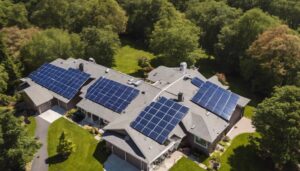
Imagine significantly reducing your monthly energy bills by harnessing the power of the sun with your own DIY solar thermal panel setup.
Not only can you save money, but you can also take control of your energy usage and make a positive impact on the environment.
But the benefits don’t stop there. By taking on this project, you’ll gain valuable knowledge about renewable energy and develop a sense of pride in your ability to contribute to a more sustainable future.
There’s much more to uncover about the advantages of DIY solar thermal panel setup, so let’s explore further.
Key Takeaways
- Solar thermal systems are a practical and efficient choice for providing hot water, space heating, and cooling.
- Selecting the right location is crucial for maximizing energy generation and ensuring easy maintenance and integration into the electrical system.
- Gathering necessary components involves researching and purchasing solar panels and equipment from various sources, considering special programs and deals, and balancing upfront costs with reliability and warranty.
- Following a step-by-step installation guide and maximizing energy efficiency through high-quality components, efficient design, insulation techniques, and regular maintenance are essential for optimal functionality and performance.
Benefits Of DIY Solar Thermal Panel Setup in Australia
| Benefit | Explanation |
|---|---|
| Cost Savings | DIY solar thermal panel setup allows you to save on energy costs by harnessing the sun’s heat to provide hot water or space heating. This can significantly reduce your reliance on traditional energy sources and lower your utility bills. |
| Environmental Friendliness | Solar thermal panels utilize renewable energy from the sun, which helps reduce greenhouse gas emissions and dependence on fossil fuels. By opting for a DIY setup, you contribute to a cleaner and more sustainable environment. |
| Energy Independence | With a DIY solar thermal panel setup, you become less reliant on the grid for your hot water or space heating needs. This provides a sense of energy independence and resilience, especially during power outages or energy price fluctuations. |
| Long-Term Savings | While there is an initial investment involved in setting up solar thermal panels, they have a long lifespan and require minimal maintenance. Over time, the savings on energy bills can outweigh the initial costs, making it a financially beneficial choice. |
| Increased Property Value | Installing solar thermal panels can increase the value of your property. Potential buyers are often attracted to homes with renewable energy systems, as they offer long-term cost savings and environmental benefits. |
| Government Incentives | In Australia, there are various government incentives and rebates available for installing solar thermal panels. These incentives can help offset the initial costs of the setup, making it even more financially attractive. |
| Educational Opportunities | DIY solar thermal panel setup provides an opportunity to learn about renewable energy systems and their installation. It can be a rewarding educational experience that empowers individuals to make sustainable choices and contribute to a greener future. |
Please note that the specific benefits and incentives may vary based on location and individual circumstances. It’s essential to research and consult local authorities or experts for accurate information regarding DIY solar thermal panel setups in Australia.
Understanding Solar Thermal Systems
If you’re looking to harness the power of sunlight to heat water or air for your home or business, understanding solar thermal systems can provide you with an efficient and cost-effective solution.
- Solar thermal systems are versatile and can be used for various applications, including providing hot water, space heating, and even cooling through absorption cooling.
- Unlike photovoltaic panels, solar thermal panels are less complex and have a more straightforward design and installation process, making them a practical choice for many property owners.
- One of the significant advantages of solar thermal systems is their high efficiency in directly converting sunlight into heat energy. This makes them a cost-effective option for heating applications, as they can significantly reduce energy bills over time.
- Additionally, solar thermal panels require proper maintenance and system design to maximize their benefits. With the right setup and care, solar thermal systems can provide reliable and sustainable heating solutions for both residential and commercial properties.
Selecting the Right Location
When choosing the location for your solar panels, it’s essential to consider the sunlight exposure and shading on your property. Maximizing solar exposure will ensure that your panels generate the most energy. Here are some tips to help you select the right location:
- Assess Sunlight Exposure: Look for areas on your property that receive ample sunlight throughout the day. Avoid shading from trees, buildings, or other obstructions that could diminish solar exposure.
- Easy Maintenance: Choose a location that allows for easy access to the panels for maintenance and cleaning purposes. This will ensure that you can keep the panels in optimal condition for efficient energy production.
- Secure Mounting Surface: Make sure the location provides a secure and stable mounting surface for the solar panels. This is crucial for the safety and longevity of your solar panel system.
- Proximity to Electrical Service Panel: Evaluate the proximity to the electrical service panel for efficient wiring and connection to the power system. This will streamline the installation process and ensure seamless integration into your electrical system.
Gathering Necessary Components
To assemble the necessary components for your DIY solar panel setup, begin by researching and purchasing solar panels and equipment from local installers, retail shops, online vendors, and Amazon. Consider checking for special programs and deals from nonprofits and utilities that offer solar equipment.
Additionally, look for used solar panels and equipment, ensuring to test them and check the manufacturing date. Contacting solar retail and wholesale outfits for used panels might also yield cost savings. It’s also worth exploring initiatives for disadvantaged communities that provide access to solar equipment, as these programs may offer resources at a reduced cost.
When sourcing materials for your DIY solar thermal panel setup, cost considerations are important. Compare prices from different suppliers and consider the long-term savings from investing in high-quality, efficient components.
Keep in mind that while purchasing new equipment can provide reliability and warranty, opting for used or discounted materials can significantly reduce upfront costs. However, ensure that used items are thoroughly inspected to guarantee their functionality and efficiency.
Step-by-Step Installation Guide
As you gather the necessary components for your DIY solar panel setup, the step-by-step installation guide will walk you through the detailed process of setting up your solar thermal panels. The guide covers each phase of the installation process, from planning to connecting the panels to the system. It includes information on selecting the right location, assembling the components, and integrating the system with the existing setup.
Detailed instructions for testing and troubleshooting the system are provided to ensure it functions optimally. Additionally, the guide offers valuable tips and recommendations for maintaining and maximizing the efficiency of solar thermal panels.
- Selecting the right location for optimal sunlight exposure.
- Assembling the components according to the provided instructions.
- Integrating the system with your existing setup.
- Testing the system and applying troubleshooting techniques if necessary.
For ongoing efficiency and performance, it’s important to adhere to the maintenance tips provided in the guide. Regular maintenance will ensure that your solar thermal panels continue to function effectively, providing sustainable energy for your needs.
Maximizing Energy Efficiency
You can optimize the energy output of your DIY solar thermal panel system by utilizing high-quality components and efficient design. Implementing proper insulation techniques and positioning the panels for maximum sunlight exposure can significantly enhance energy efficiency. Additionally, incorporating a backup energy storage system ensures that you can make the most of the energy captured. Here’s a table to illustrate how these factors contribute to maximizing energy efficiency:
|
Factors
|
Impact
|
|---|---|
|
High-Quality Components
|
Ensures durability and optimal performance
|
|
Efficient Design
|
Maximizes energy capture and utilization
|
|
Proper Insulation
|
Minimizes heat loss and enhances energy retention
|
|
Backup Storage
|
Ensures continuous energy availability
|
Frequently Asked Questions
What Are the Advantages of Solar Thermal System?
You’ll find that a solar thermal system is cost-effective and energy-efficient. It’s a great way to save money and reduce your environmental impact. Plus, you’ll enjoy the satisfaction of using renewable energy in your home.
Is DIY Solar Better?
You might find that DIY solar installation is better for you. The installation process can be rewarding, and it often leads to significant cost savings and improved energy efficiency for your home.
What Is the Meaning of DIY in the Solar System?
In DIY solar, you handle the installation process yourself, customizing the setup to fit your needs. This can lead to energy efficiency and cost savings, plus the chance to learn new skills.
What Is the Use of Solar Thermal Panels?
Solar thermal panels are used to capture sunlight and convert it into heat for various applications. They provide benefits such as cost savings, reduced carbon footprint, and versatility in heating water, and spaces, and even powering cooling systems using solar energy.
Conclusion
So, if you’re looking to save money, customize your solar thermal system, and gain a sense of accomplishment, a DIY solar thermal panel setup is the way to go.
With the right location, components, and installation guide, you can maximize energy efficiency and reap the benefits of solar energy.
It’s a cost-effective and rewarding option for homeowners who want to harness the power of the sun.



